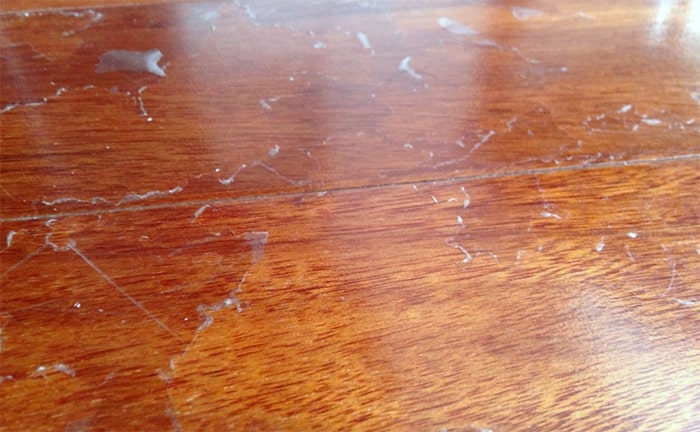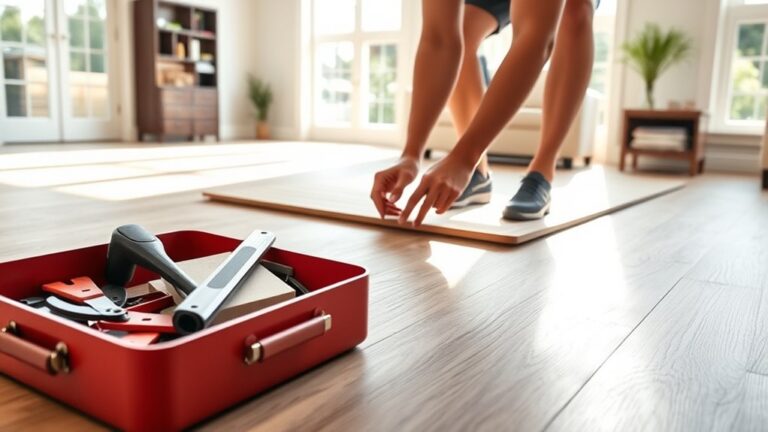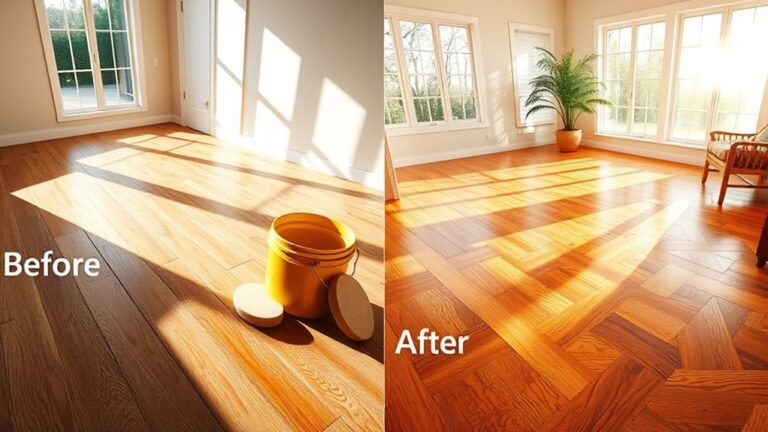To fix peeling polyurethane on hardwood floors, sand the affected area and apply a new coat of polyurethane for a seamless finish. Hardwood floors add a touch of elegance and warmth to any home.
However, over time, the polyurethane coating on these floors may start to peel, leaving them looking worn and unattractive. Luckily, you can easily remedy this issue with a few simple steps. We will guide you on how to fix peeling polyurethane on hardwood floors.
By following these instructions, you can restore the beauty of your floors and protect them for years to come. Let’s dive in and explore the process of fixing peeling polyurethane on hardwood floors.
Understanding The Problem: Peeling Polyurethane On Hardwood Floors
Peeling polyurethane on hardwood floors can be a frustrating problem to deal with, but understanding the signs and causes can help you fix it effectively. One of the signs of peeling polyurethane is when the protective coating starts to bubble or lift away from the surface of the floor. This can leave patches of exposed wood, making the floor vulnerable to damage.
There are several causes for peeling polyurethane. One common cause is inadequate surface preparation before applying the polyurethane. If the floor is not properly cleaned and sanded, the polyurethane may not adhere well to the surface, leading to peeling over time. Environmental factors such as high humidity or temperature fluctuations can also impact the adhesion of the polyurethane, causing it to peel.
To fix peeling polyurethane on hardwood floors, it is important to properly remove the damaged coating and prepare the surface. This may involve sanding the affected area, cleaning it thoroughly, and then applying a new layer of polyurethane. It is recommended to follow manufacturer instructions and use high-quality products for the best results.

Preparing Your Floor For Rescuing
Preparing Your Floor for Rescuing: Learn how to fix peeling polyurethane on hardwood floors with these helpful tips. Follow step-by-step instructions to ensure a smooth and successful restoration process.
Cleaning The Floor Surface Thoroughly
To effectively fix peeling polyurethane on hardwood floors, it is crucial to begin by thoroughly cleaning the floor surface. Start by dusting the floor to remove any loose debris, using a broom or a vacuum cleaner with a soft brush attachment. Next, use a mild hardwood floor cleaner diluted in warm water to mop the floor, ensuring all dirt, grime, and residue are removed. Remember to wring out the mop well to prevent excessive moisture on the floor. Let the floor air dry completely.
Assessing The Extent Of Damage
After the floor is clean and dry, assess the extent of the damage caused by the peeling polyurethane. Inspect the affected areas carefully, looking for signs of peeling, flaking, or discoloration. Determine if the damage is localized or widespread, as this will help guide your approach in the repair process.
Gathering Necessary Tools And Materials
Before you begin the repair work, gather all the necessary tools and materials. This may include sandpaper or a sanding block, a dust mask, a floor scraper, an appropriate polyurethane finish, a paintbrush or roller, clean rags, and a floor buffer (if applicable). Having these items ready will ensure a smooth and efficient repair process.
Step-by-step Guide: Rescuing Your Hardwood Floors
Removing the peeling polyurethane from your hardwood floors is essential to restore their beauty and protect them in the long run. Start by scraping off any loose polyurethane carefully using a putty knife or scraper. Be gentle to avoid damaging the floor surface. Next, sand the floor surface with sandpaper to create a smooth and even base. Make sure to remove any dust or debris by vacuuming and cleaning the floor thoroughly.
When it comes to applying the new polyurethane, it is crucial to choose the right product. Consider factors such as durability, finish, and compatibility with your floor type. Prepare the polyurethane according to the manufacturer’s instructions, ensuring you have adequate ventilation. Begin by applying the first coat using a brush or roller, following the wood grain pattern.
After the first coat, sand the floor between coats to remove any imperfections and promote adhesion. Use a fine-grit sandpaper and carefully wipe away the dust. Apply subsequent coats, usually 2-3, to achieve a smooth and glossy finish. Keep in mind that each coat requires specific drying and curing time before applying the next layer.
Once all the coats are complete, focus on the finishing touches. Use a buffing or polishing machine, or simply a soft cloth, to give the floor a final shine. Finally, clean up the working area by removing any leftover materials and tools. Admire your beautifully restored hardwood floors and enjoy their renewed beauty and durability!
Maintaining And Preventing Future Issues
Regular cleaning and maintenance routine are essential for keeping your hardwood floors in top condition and preventing peeling issues. Here are some tips to help you maintain your floors:
- Use a soft mop or microfiber cloth to regularly remove dust and dirt. Avoid using harsh or abrasive cleaners that can damage the polyurethane coating.
- Wipe up spills immediately to prevent them from seeping into the wood and causing damage.
- Avoid excessive moisture by using mats at entryways and wiping up excess water or spills promptly.
- Place felt pads under furniture legs to prevent scratches and damage to the polyurethane.
To avoid common mistakes in polyurethane application, remember the following:
- Follow the manufacturer’s instructions carefully when applying polyurethane.
- Ensure the floors are properly prepped and cleaned before applying the polyurethane.
- Avoid over-applying the polyurethane as it can lead to peeling and other issues.
- Allow sufficient drying time between coats and avoid heavy traffic on the floors until the polyurethane is fully cured.
By following these tips and maintaining a regular cleaning and maintenance routine, you can prevent future peeling issues on your hardwood floors.
Frequently Asked Questions On How To Fix Peeling Polyurethane On Hardwood Floors
How Do You Fix Peeling Polyurethane On Hardwood Floors?
To fix peeling polyurethane on hardwood floors, start by sanding the affected area lightly with fine-grit sandpaper. Clean the area thoroughly to remove any dust or debris. Apply a new layer of polyurethane using a paintbrush or roller, following the manufacturer’s instructions.
Allow it to dry completely before using the floor again.
What Causes Polyurethane To Peel On Hardwood Floors?
Polyurethane can peel on hardwood floors due to various reasons. It could be improper application, high humidity levels, poor surface preparation, or using low-quality polyurethane. Additionally, excessive wear and tear, water damage, or chemical reactions with cleaning products can also cause peeling.
Understanding the root cause can help prevent future issues.
Can You Fix Peeling Polyurethane Without Refinishing The Entire Floor?
In some cases, you can fix peeling polyurethane without refinishing the entire floor. If the peeling area is small, you can sand it lightly and apply a new coat of polyurethane specifically on that spot. However, if the peeling is extensive or the floor has other imperfections, it may be necessary to refinish the entire floor for a seamless finish.
How Can I Prevent Polyurethane From Peeling On Hardwood Floors?
To prevent polyurethane from peeling on hardwood floors, proper surface preparation is crucial. Ensure the floor is clean and free from any contaminants before applying polyurethane. Use high-quality polyurethane and apply thin, even coats with sufficient drying time between each layer.
Avoid excessive moisture and use gentle cleaning products suitable for polyurethane finishes. Regular maintenance and protective measures can also help prolong the life of the finish.
Conclusion
Fixing peeling polyurethane on hardwood floors can be a daunting task, but with the right knowledge and techniques, it is definitely achievable. By following the steps outlined in this blog post, you can restore the beauty and integrity of your hardwood floors.
Remember to always take proper precautions and use the recommended products for the best results. With a little patience and effort, you can transform your peeling floors into a stunning centerpiece of your home. Don’t let peeling polyurethane discourage you – take action today and enjoy the renewed beauty of your hardwood floors.




